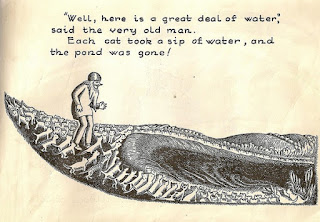Millions of Cats, written and illustrated by Wanda Gag, is a time-tested classic picture book in the truest sense: first published in 1928 (it won the Newbery Honor Award the following year) Millions of Cats is the oldest American picture book in print. Though I had never heard of this book before this assignment, it’s easy to see why it has endured for almost a century. Gag combines crisp folksy black and white art with a simple relatable story, playful use of language, and an admirable message at the end to make a book that will appeal to children and parents alike.
Using Gag’s beautifully detailed illustrations and hand-written text, the book tells the story of an old man who sets out on a quest to find a cat for his lonely wife. What he finds instead is a hill covered with, as the book puts it: “Cats here, cats there, cats and kittens everywhere, hundreds of cats, thousands of cats, millions and billions and trillions of cats” who then follow the old man home across the countryside. Through its simple language and artwork, this book could act as a way to introduce children to the concept of incredibly large-scale numbers. Scenes such as the one in which each cat takes a single drink of water, and in doing so drain a lake, help make the idea of millions of cats into something that even a young child can put into perspective and wrap his or her mind around.
The book also provides something of a moral in the form of a homely cat who is the lone survivor when the other cats tear each other to shreds in an argument about which of them is the cutest. The scrawny cat who didn’t think much of himself and so didn’t join in the fight gets to live with the old man and woman where he fattens up and grows into a healthy happy cat. This message could be interpreted a number of ways (paradoxically, it seems to me to be a message about both the dangers of pride and the importance of seeing worth in yourself) and children may find different meanings in the story as they return to it again and again.


